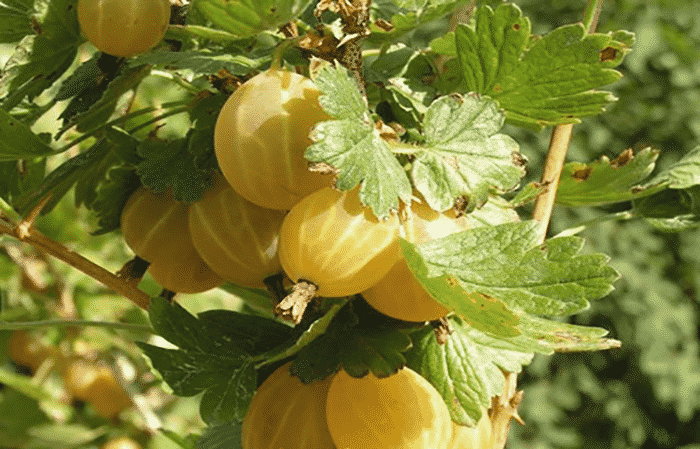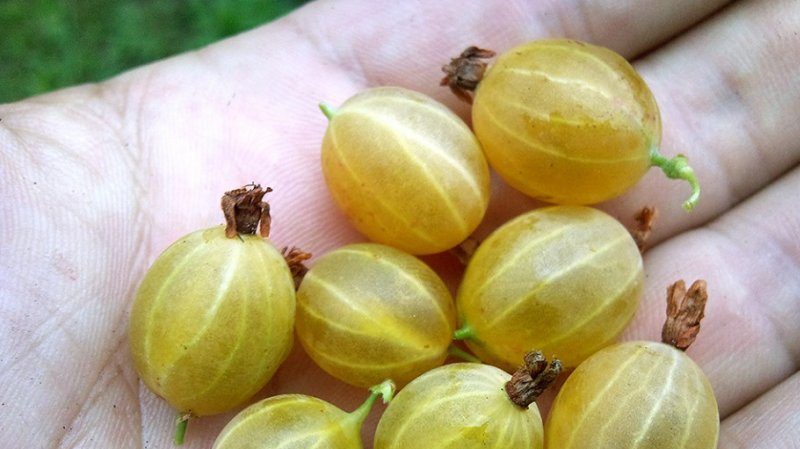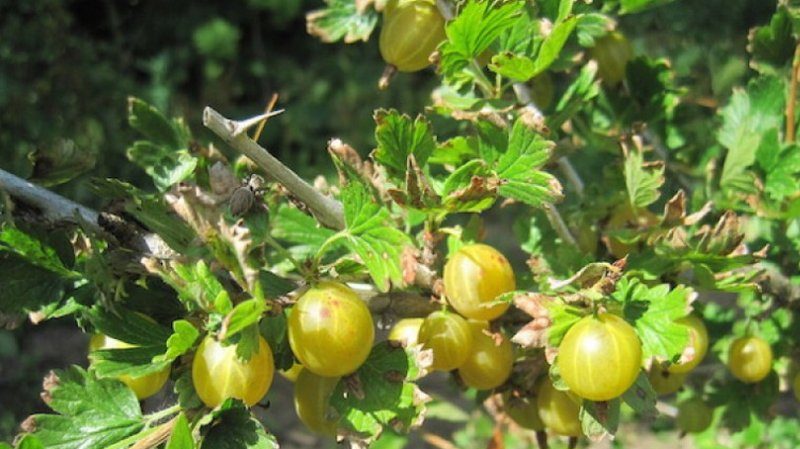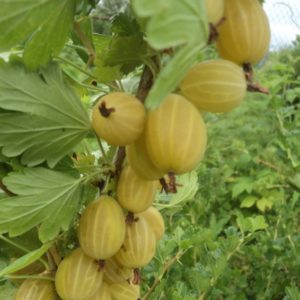Early ripening gooseberry variety "Dzintars Kursu"
Gooseberries are a crop that can be found in almost every vegetable garden or garden in all regions of our country. Kurshu Dzintars is a mid-early, yellow-fruited gooseberry variety, well adapted to the realities of the Russian climate. Designed for cultivation in summer cottages and garden plots.
What kind of gooseberry is this?

Kursu Dzintars was bred by Latvian breeders. Obtained as a result of crossing two other Baltic varieties Pellervo and Stern Rajiga.
It is not listed in the register of breeding achievements of the Russian Federation, but it was successfully tested in the Republic of Belarus (1997) under conditions corresponding to the climate of central Russia.
Characteristics and description of bushes
The bush is tall and compact, decorative, has medium spreading. Straight and thin shoots are dotted with many small and sharp brown thorns, located mainly singly, occasionally double or triple. The leaves are medium in size, round in shape and divided into 3-5 lobes. The upper surface of the leaves is covered with shallow wrinkles and has a faint matte sheen.
Normally, one bush consists of 15-20 shoots of different ages. The flowering period begins in mid-May and lasts until early August, when the first berries are formed. During the season, 4-6 kg of fresh berries are harvested from one bush, or 5-7 tons from 1 hectare of area. Harvest weight depends mainly on the quality of care.
Characteristics and description of fruits

The harvest consists of medium-sized berries of approximately the same size.The weight of ripe berries is about 2.5 g, the shape is oval, the color is yellow with clearly visible veins.
Reference. Gooseberry fruits are rich in vitamin C. Their regular consumption helps in the treatment of obesity, anemia and hypertension. Delicious compotes, wines and liqueurs are prepared from them.
The berries are sweet in taste, juicy, have a pronounced aroma, do not fall off the branches, and are easily transported and stored. They are eaten fresh or prepared: made into jam, preserves, compote and marmalade, and also added to fillings for pies and muffins. Overripening, the berries lose their taste.
Advantages and disadvantages of the variety
Advantages of the variety:
- stable yield (the ability to bear fruit for years and decades in a row without loss of harvest volumes);
- pleasant, decorative appearance of the bush;
- pleasant taste of berries;
- resistance to harsh winter conditions;
- good immunity to common gooseberry diseases.
There are fewer disadvantages:
- relatively small berries;
- a large number of sharp thorns.
Growing technology

The planting site should be illuminated by the sun and have plenty of room for an adult bush, at least a meter from the nearest walls and fences. Despite the fact that gooseberries love moisture, they do not do well in places where moisture accumulates. Ideal soil is with plenty of humus and sand.
Landing dates and rules
Seedlings are rooted in the fall (September-October) at least two weeks before the onset of frost or in the spring, after the frosts have completely gone away. If spring comes late, the cuttings can be rooted in a greenhouse or greenhouse, placing them in a container with a mixture of sand and peat in half. In order for the cuttings to take root, they are immersed in an aqueous solution of heteroauxin (3 parts heteroauxin to 20 parts water).
On a plot of land that has previously been treated against weeds, planting holes are prepared, the volume of which should be twice the volume of the roots of the seedling. A small mound is made at the bottom of the pit. The distance between neighboring bushes is at least 1.5 m.
Before planting, the roots of the seedling are cleared of old soil, straightened, and placed on a mound. The removed soil is mixed with fertilizers and poured into the hole with the seedling; the root neck is not buried. After planting, the seedlings are watered at the rate of two buckets of water per plant, mulched with peat, compost or hay. Excess shoots are cut off.
Further care
Young gooseberries need a garter. The stem is tied to a vertically driven peg to prevent bending and breakage by gusts of wind.
Gooseberries are watered directly into the tree trunk without using sprinkling. Do not pour water on the leaves to prevent them from getting burned (in sunny weather) or getting sick (in cloudy weather).
If the summer turns out to be dry, gooseberries are watered more often, especially in July and August - at a time when buds are actively being formed. The bush does not tolerate excess moisture in the soil, especially at the root collar: this makes it more vulnerable to diseases and can lead to rotting of the roots.
After the first application of fertilizers, subsequent ones are carried out no earlier than three years later. Gooseberries are fertilized with rotted manure or mineral additives (superphosphate, potassium sulfate) in late May-early June. You should not fertilize in late summer and autumn: this will stimulate the growth of fresh shoots that will not be able to survive the winter. When calculating the dosage of fertilizers, consider the type of soil.
The Kurši Dzintars gooseberry sprouts vigorously, so to obtain large berries it is necessary to regularly remove excess branches.Make sure that both young and old branches remain on the same bush.
The bush is pruned at the beginning of spring (weak and dead branches) and at the end of autumn (old, diseased and branches growing near the ground). From bushes older than seven years old, dry and infertile branches should be removed every year, and the oldest shoots should be partially cut off. The optimal number of young shoots on one bush is 5-6 pieces. All shoots are cut to the base using a well-sharpened and clean tool.
Important. Shoots with growing berries may fall to the ground due to weight. The berries rot when they come into contact with the ground, so it is recommended to prop up or tie up particularly heavy branches.
Possible problems, diseases, pests
The Kursu Dzintars variety is resistant to anthracnose and powdery mildew, susceptible rust and septoria. All diseases are treated with Bordeaux mixture and 3% copper sulfate solution, if necessary with special preparations, for example, “Agrolekar”.
Treated like a plant, and the soil around it, and, if desired, neighboring gooseberry bushes for prevention purposes. Alarming symptoms – drying of leaves, appearance of spots, midges, etc.
Gooseberries are vulnerable to pests:
- scale insect;
- fire;
- sawflies;
- aphids.
To prevent insects from encroaching on the plant, every autumn the ground under it is cleared of plant debris, dug up and treated with insecticides “DNOC” (for scale insects), “Karate”, “Iskra” (for moth), “Aktara” and the same “Iskra” (from sawfly, aphids). In spring, it is permissible to spray young foliage with pest repellents.
Wintering
In autumn, the ground around the plant is hilled up, the bush itself is tied up, covered with spruce branches or non-woven covering material.If there is little snow in winter, add additional snow to the bush so as to protect it from frost, but not damage it.
Reproduction
The Kursu Dzintars variety is propagated vegetatively. The fastest and most effective method is layering. To do this, the shoot is retracted, tilted to the ground and fixed with metal hooks in a horizontal position or in the shape of an arc. In the first case, the shoot is fixed in several places (several new shoots grow), in the latter - only in one place, in the middle (one strong shoot grows).
For old plants that do not have plastic shoots, vertical layering is preferable. To prepare the bush, in the fall it is completely rid of old branches. The next year, fresh shoots grow (to help them, the plant is fertilized and hilled), after rooting they are planted.
For bushes under five years old, another method of vegetative propagation is also suitable - using cuttings, lignified, young or combined. When cutting, the shrub is carefully dug up along with the roots and divided into several parts. Gooseberries have a good ability to regenerate and, in particular, root, which makes the method very effective.
Regional characteristics of cultivation
Kurshu Dzintars, like other “spiky” gooseberry varieties, is well adapted to cold, so it can be grown in the vast majority of regions of Russia.
Kuršu Dzintars is frost-resistant and drought-resistant, belongs to the fourth climatic zone. This variety has high adaptive abilities and is unpretentious to environmental conditions. In winter, even if uncovered, it can withstand frosts down to -32°C.
Pollinator varieties
Kuršu Dzintars is a self-fertile variety: up to 20% of the flowers are pollinated by the bush’s own pollen.Consequently, other pollinating bushes are not necessary for it.
However, cross-pollination improves not only the number of berries, but also their size and taste. To increase the yield of a variety, it is recommended to grow it next to other varieties with similar flowering periods.
Reviews from summer residents
It is difficult to find negative reviews from Russians about the variety.
Marina, Balakovo: “I have had Kurši Dzintars gooseberry bushes growing for several years now. The bush looks beautiful, especially when covered with yellow shiny berries. The berries are sweet, they contain a lot of vitamins, the only drawback is that they are inconvenient to pick, the branches are too thorny.”
Pavel, Dimitrovgrad: “Kurshu Dzintars is the best gooseberry of all the varieties that I have ever tried. From its sweet berries I make excellent homemade wine and beautifully colored jam.”
Conclusion
The gooseberry variety Kurshu Dzintars is one of the best varieties for growing in Russia. It adapts well to climatic conditions, care for it does not require much work, and the sweet yellow berries are tasty and have many uses in cooking. The lifespan and fruiting of the bush with reasonable care is more than 30 years.